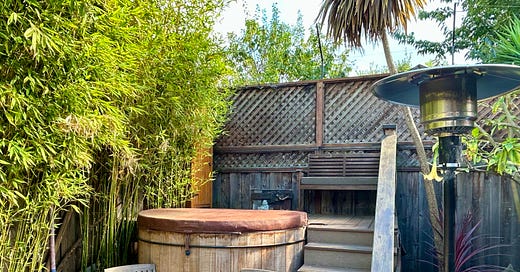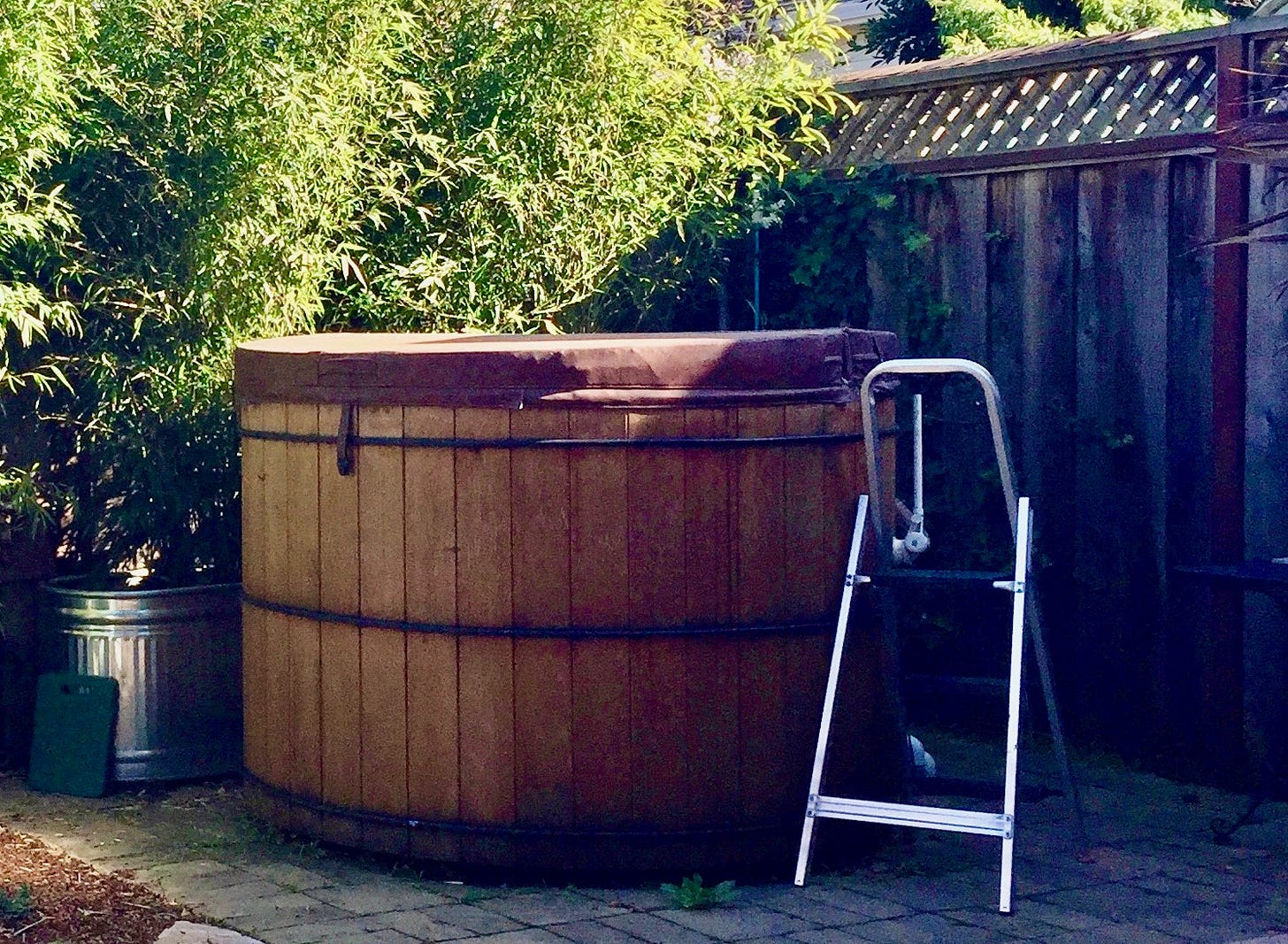The other day, we took a small step on our ongoing electrification journey: we got a heat pump heater for our hot tub. That’s a heater that runs on electricity, using the same principle as an air conditioner or a refrigerator, but in reverse. Instead of generating heat, which takes a lot of energy, it moves heat from the surrounding air into the water — making it much more efficient than other types of heaters.
Our hot tub goes all modern
When we moved into our house, it came with a hot tub in what’s now known as the R&R Spa (our backyard). It wasn’t exactly the hot tub I would have gotten, nor was it placed ideally in the yard. But I could hardly complain. What a first-world problem! I mean, we’re living the California dream! Sort of.
Our hot tub is actually a very nice cedar one with a seat all around the sides, so you can sit up in it comfortably. But there was no way to get into it without a stepladder, till we had a deck built for it. It had some quirks and took a bit more maintenance than your average hot tub. And it came with a troublesome gas furnace that was always conking out.
Since we aren’t rolling in dough, we weren’t planning to get a new heater anytime soon. But this year, the cranky old gas furnace started giving out for real. Plus Benny, from the company that made our hot tub, told us there was finally a good heat pump hot tub heater on the market. It was time to take the plunge. Or the soak.
Some expensive electrical work later, we were ready for our new heater. It was hooked up by Benny and the Jets, as I think of him — because, well, how could I not? And I do get that song stuck in my head every time he comes over.
This weekend, we enjoyed our hot tub for the first time in months. Did the dip feel all the sweeter knowing it was powered by mostly clean electricity? Yes, it did.
There’s an app for that
As I’ve mentioned before, I have a thing for home automation apps. I use apps to see our solar panel production and control our furnace, water heater, irrigation system, and some light bulbs. You’ll be glad to know that we can also control our hot tub heater with an app:
I can check the temperature from inside the house to see if the tub is ready for our dip. When we get out of the tub and relax on the deck to dry off, I can easily turn off the jets and enjoy the peaceful sounds of the nearby freeway. Well, it’s really pretty quiet in our neighborhood — quiet enough to enjoy an evening soak in the hot tub.
What’s next?
We’re getting close now to being fully electrified; all that’s left to tackle is our furnace. That biggest-ticket item will have to wait, because it requires so much cash. We’re hoping for some income-based incentives promised by the Inflation Reduction Act — which just turned two! — to materialize. At the moment, all that’s available is a $2000 tax credit, which is nice but not nearly enough to offset the potential $18,000+ cost in the Bay Area.
Rewiring America’s calculator for the IRA incentives used to show that Rafael and I could get $8000 in income-qualified upfront rebates in addition to that $2000, making a heat pump heater more affordable (the income qualifications aren’t as low as you might think, and ours has been teetering on the edge of qualifying). Now, their site says, “The federal guidelines allow for a discount of up to $8,000. However, rebates will be implemented differently in each state, so we cannot guarantee final amounts, eligibility, or timeline.”
I hear rumors that the incentives have been approved for California and should be here by next year. We’ll see.
So expensive
Even at $8000 or so after the potential incentives, a heat pump heater is a big purchase — especially for lower-income families. And what do renters do?
Some cheaper and more portable options are coming online that could help renters, including some that could be put in place by building owners. But many of these, and the more standard heat pump heaters, may still be out of reach for people struggling with the high prices of housing and so much else in our current economy.
Plus, to electrify fully we’re also talking water heaters, clothes dryers, stoves, cars … it all adds up to a lot. It can make sense to electrify if you can scrounge up the cash and are powering it with practically free solar energy, but for most people, full electrification is still out of reach.
It’s only going to get worse. As more people and businesses electrify and AI use increases, electricity demand is outpacing supply, driving up prices by crazy amounts in some regions. We have solutions for this, like virtual power plants, but they need to be deployed much more quickly and widely than they are.
And it’s not just electricity prices that are spiking.
All this electrification also means there will be fewer customers for fossil gas (please, don’t call it natural gas!). In California, the large investor-owned utilities like PG&E are putting big bucks into upgrading gas infrastructure, just as fewer customers are using it. That means that the smaller pool of customers who do keep using gas will be left footing the bill. According to an analysis by Gridworks, a decarbonization consulting firm, “California’s current trajectory could lead to residential gas rates increasing from about $1.50 per therm today to as much as $19 per therm by 2050.”
I’m down with electrification, really down with it. But we need to find ways to make it accessible for everyone.
People smarter and more knowledgeable than I am are working on this, and there are plenty of solutions — like the aforementioned virtual power plants. Initiatives like the federal government’s $7 billion Solar for All program, which plans to “deliver solar to more than 900,000 low-income and disadvantaged households nationwide,” will help.
We need a lot more of these, and we need to acknowledge that clean energy and electrification are not currently accessible to all — or even to most. If the electrification journey is this hard for privileged, middle-class people like Rafael and me, imagine how hard it is for the 44% of Americans who say they could not pay an unexpected $1000 expense from their savings.
Electrification and clean energy are not “nice-to-haves.” They’re essential if we’re to have any hope of dealing with the climate crisis. We have to make it easier for everyone to make the switch.
This is the eighth in my home electrification and renewables series. Previous posts:








I hope you will consider finishing your journey with https://www.QuitCarbon.com - we’d love to offer you our free, expert assistance with getting your home all the way off gas!
Trane Commercial has thermal energy storage - I wish there were more options for residential thermal energy storage. Take heat out of the house (AC) and store it in the hot tub. Recover heat from plumbing to heat the house in winter.
https://www.trane.com/commercial/north-america/us/en/products-systems/energy-storage-solutions.html